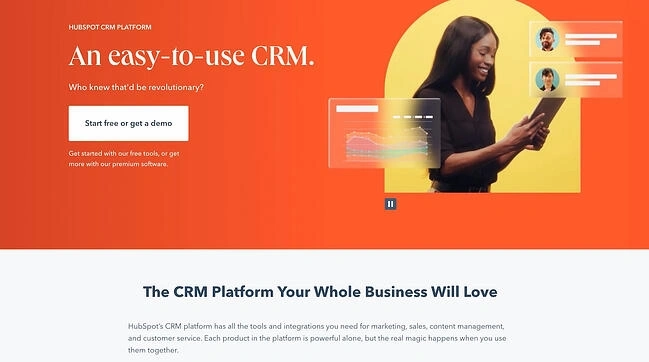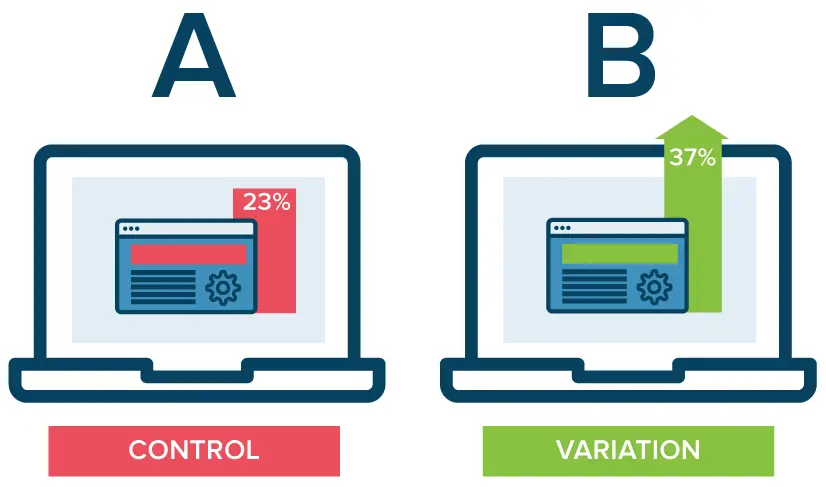Imagine being at a bustling farmers market. Stalls of fresh fruits, homemade jams, and artisan breads surround you.
You’re drawn to two apple stands side by side.
Both offer juicy red apples, but one has a sign: “Picked this morning from our local organic farm.”
The choice becomes easy.
This is the power of a compelling value proposition. It helps your offering get noticed in the swarmed market.
But what if you’re not selling apples? How do you craft a compelling value proposition for your business or brand offering? And how can it drive sales and increase conversion rates?
Let’s uncover these answers and more.
A quick value proposition definition
A value proposition is a powerful tool that underpins marketing strategy. But what exactly does that mean?
A value proposition is a compelling reason for a potential customer to choose your product or service. It helps potential customers quickly understand what you offer. It also gives them a reason to choose you over competitors.
This isn’t just about listing the features of what you’re selling. Instead, it’s about demonstrating how these features address your customers’ needs and wants.
A good value proposition connects company offerings and customer desires in one simple statement.
Here are a few famous examples to illustrate:
- Uber – “Tap the app, get a ride.”
- Slack – “Where work happens.”
- Zoom – “Bringing the world together, one meeting at a time.”
These value propositions are effective because they are clear and concise. They communicate the unique benefits that the companies offer to their customers.
Want to deliver exceptional value to your customers? Check out Canny’s customer feedback management tools.
The power of clarity
At its heart, a great value proposition offers clarity. It answers questions like ‘What do I get if I purchase this product?’ without ambiguity or complexity.
To make sure it resonates with customers, choose every word carefully. It must reflect not only the tangible benefits, but also the emotional ones. You know, the ones that give a feel-good factor to drive sales.
Focused on customer experience
An effective value proposition always keeps an eye on customer experience. If we look at Harvard Business School as an example, they don’t simply offer courses. They promise transformative education that prepares students for leadership roles.
Making it visible
Let’s not forget how crucial visibility is. Your unique value proposition needs to shine in every corner of your marketing efforts. From the product design drawing board straight through to your social media platforms.
Crafting your value proposition statement
Crafting your proposition starts by identifying pain points among your ideal customers. What problem are they looking to solve? How does using your product fill those gaps better than other available solutions?
This is useful when building your product. It helps steer your product development to a product-market fit.
It’s also important for your marketing campaigns. They need to address these key points clearly. When people read them, there should be no unanswered questions left. Your job is to convince them to opt for you versus the competition.
Aligning your benefits with customer pain points helps you build a competitive advantage.
Crafting your value proposition doesn’t need to be overly complex. It should just be a short sentence that shares the value your company offers.
The core elements: benefit and differentiation
A compelling value proposition clearly communicates two things:
- What benefits are we offering?
- How does our offering stand out from the competition?
Here’s a basic example. If everyone at the market sells apples, oranges would be an interesting alternative. They would appeal to those needing something different.
Try to find a similar differentiator for your product. In an apple orchard, try to be an orange.
Finding your unique selling point (USP)
Your USP is at the heart of an effective value proposition. It’s what sets you apart from competitors in your market space.
To identify yours, consider what problems your company solves. How does it improve people’s lives? Maybe even look at common pain points within the industry to see how you address them better than others.
Making it resonate with your target audience
Ensuring it resonates with your audience is essential to crafting your value proposition. Understand their needs, wants, and how they perceive value.
Knowing your target customer’s pain points helps shape your offering to speak directly to them. This guides how you build and market your product.
To optimize your message further, consider who exactly will be reading or hearing it. You wouldn’t speak to an executive buyer the same way as a teenager looking for cool sneakers. So, don’t write a one-size-fits-all copy.
A great way to visualize this is by creating a value proposition canvas.
Using a value proposition canvas
A value proposition canvas is a tool that helps you visualize the key aspects of a product’s value proposition. It helps you understand how your products or services meet the needs of your target customers. It also explains why they should choose you over competitors.
The canvas consists of two main sections: customer profile and value map. The customer profile outlines:
- Who your customer is
- What jobs do they need to get done
- Their pains (problems)
- Their gains (benefits)
On the other hand, the value map describes how your product addresses those jobs, relieves pains, and creates gains for them.
Essentially, it ensures alignment between what you’re offering and what your customers seek.
There’s one specific case when this becomes particularly useful. That’s when you plan new features or improve ones within Canny (our user feedback management tool). This value proposition canvas helps you focus on elements that deliver real value to users.
It can also uncover opportunities to innovate within your offerings. At the same time, you’ll stay relevant to our audience’s changing needs.
Focusing on benefits over features
Focusing too much on features over benefits is a common mistake. Remember – it’s not just about what your product does. It’s about how it can help or fix a common pain point for the customer.
Your marketing campaigns need to highlight these benefits clearly.
Communicating your value proposition
The last step is communicating your value prop across all marketing materials and channels. Remember, consistency is key when you’re aiming to create strong brand recognition.
Your value proposition should shine brightly at every possible touchpoint with potential customers. Website, email marketing, social media accounts, and advertisements should reflect your value proposition.
Customers should instantly know what makes buying from YOU worthwhile wherever they see your brand. Your aim here is not just for people to see your company. They should also know how uniquely equipped you are to solve their pain points.
Testing and refining your value proposition
Developing a solid value proposition doesn’t end at creation. It’s an ongoing process. It requires testing, refining, and understanding your customers’ buying behaviors.
A/B testing: the path to perfection
A vital step in this journey is A/B testing. You’ll want to test two versions of your value prop to see which yields the best results.
This helps you identify what resonates with your potential customers and what drives them away. Be sure to test based on data-driven decisions rather than assumptions or hunches.
The role of customer support
Your customer support team plays a crucial role too. They’re the front line for gathering feedback from real users about how well your product fills their needs. This information directly relates to the strength of your value proposition.
Tuning into these conversations helps uncover areas where you need improvements. This way, you can enhance your user experience and conversion rate optimization.
Leveraging customer feedback for constant improvement
An optimized value proposition isn’t static. It evolves based on feedback and changing market dynamics. This makes customer feedback invaluable.
Canny can help here by allowing you to manage user feedback efficiently. A feedback board centralizes customer feedback from all sources.
This lets you quickly identify how people feel about your product and how well it aligns with your value proposition.
This real-time insight makes it easy to quickly iterate on your value proposition.
Understanding buying behaviors
Last but not least, getting a grip on buying behaviors is critical. Knowing why people choose your product over competitors helps you improve your unique selling point. The same is true of knowing why they don’t choose your product.
Your sales team is a wealth of knowledge here. They can tell you why they’re closing or losing deals. That info helps you identify how well your value proposition aligns with customers. If it’s missing the mark, you might want to adjust.
Creating a powerful proposition statement is a great first step in marketing your product. But, you need to maintain its relevance through continuous refinement.
5 types of value propositions
Understanding and effectively communicating your value proposition is crucial. Let’s look at five types of value propositions that help you do that.
All benefits
This approach lists every possible advantage a customer gets from your product. This method may seem overwhelming at first glance. However, it provides an exhaustive overview which may appeal to customers with diverse needs.
Example: Spotify – music for everyone
Spotify provides access to millions of songs for free. They also offer the option to upgrade to a premium account for an ad-free experience and additional features. It’s about making music accessible to everyone, everywhere.
“Music for everyone.”
This value proposition makes it clear that everyone can use their service, regardless of budget.
Favorable points of difference
This type emphasizes what sets your offering apart from others in the market. It might be superior quality, innovative features, or exceptional customer service. The key here is not just stating these differences. You also need to show how they translate into tangible benefits for consumers.
Example: Airbnb – belong anywhere
Airbnb turned the travel industry upside down using a simple sentence.
“Belong anywhere.”
This statement gives off vibes of comfort and acceptance. This appeals to customers who value unique experiences over standard hotel stays when traveling.
These examples highlight the power of a compelling proposition in setting your brand apart.
Take the time to contemplate what makes your product distinctive and attractive.
Resonating focus
This takes one compelling benefit and makes it the centerpiece of communication efforts. It’s most effective when you identify an attribute that resonates with your target audience’s needs.
Example: Slack – where work happens
In our busy world, simplicity often trumps all else. This is where Slack shines. Their straightforward proposition
“Where work happens.”
It instantly resonates with target buyers seeking more efficient communication channels in their workspace.
Quantified value
If you can quantify the advantages your products provide, use this approach. Things like cost savings over time or increased productivity percentages are good examples. They lend credibility to claims about your product’s effectiveness. This helps prospects understand exactly what they stand to gain through adoption.
Example: Tesla – electric vehicles redefined
Tesla’s approach focuses on quantifiable benefits. They highlight how customers can save on fuel costs, reduce maintenance expenses, and contribute to environmental sustainability.
“Electric vehicles redefined.”
They hone in on those benefits by showcasing figures like:
- The number of miles you can drive per charge
- The money saved on gas and maintenance over time
This way, Tesla makes a compelling case for their cars’ long-term value and efficiency.
Targeted segment propositions
Last are targeted segment propositions. Here, you tailor the messaging specifically for a particular audience group. It recognizes that different segments may value various aspects of your product differently. This method seeks to speak directly to their unique needs or challenges.
Example: Nike – empowering women in sports
Nike’s targeted campaigns for female athletes are a prime example of this approach. They create products and marketing narratives that specifically address women’s needs, challenges, and aspirations in sports.
“Dream crazier.”
Campaigns like “Dream Crazier” highlight stories of female athletes breaking barriers. This deeply resonates with women who face similar challenges.
Each type of value proposition has its own strengths. The best one for you depends on your product, target market, and competitive landscape.
Value propositions – helping your customers choose you
Thanks for joining us in exploring value propositions. We hope you picked up some pointers that will help you connect with your customers.
If you’d like to get a pulse on how your customers connect with your product, get a free Canny account. It lets you centralize all customer feedback in one place. That helps you understand your customers and build powerful value propositions.











